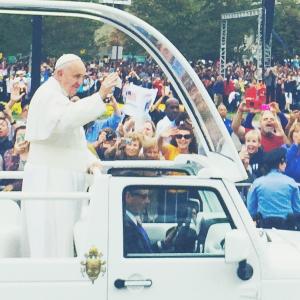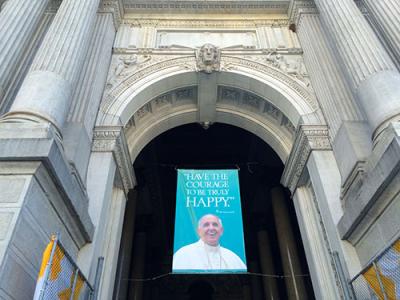As an aspiring theologian and a practicing Roman Catholic, I couldn’t have asked, prayed, or begged for better luck: The Catholic World Meeting of Families and part of Pope Francis’ first visit to the United States recently took place in Philadelphia—practically the backyard to my Manhattan apartment.
 The World Meeting of Families is a Catholic conference that takes place every three years, but this was the first in North America. The World Meeting is a legacy of Pope John Paul II; the first gathering took place during his papacy in 1994. It focuses on the needs, concerns, and wellbeing of Catholic families in the modern world; as the website for the Meeting explains: “At this conference, families share their thoughts, dialogue and prayers, working together to grow as individuals and family units.”
The World Meeting of Families is a Catholic conference that takes place every three years, but this was the first in North America. The World Meeting is a legacy of Pope John Paul II; the first gathering took place during his papacy in 1994. It focuses on the needs, concerns, and wellbeing of Catholic families in the modern world; as the website for the Meeting explains: “At this conference, families share their thoughts, dialogue and prayers, working together to grow as individuals and family units.”
In addition to several keynote addresses each day, there were dozens of breakout sessions before and after each main speaker. The four-day Meeting touched on a range of topics—from managing finances and caring for the elderly to preparing for marriage and the role of family in society. There was a simultaneous Youth Conference, a film festival, daily Masses and confessions offered, and several pop-up museums and exhibits throughout Philadelphia to edify and entertain the 18,000 who traveled from over 100 countries to attend.
It was my first time at a World Meeting, but it reminded me of other large-scale Catholic events I’ve attended (like the L.A. Religious Education Congress), so it felt familiar. These events often feel like a microcosm of the American Catholic Church—a spectrum of ideas and people, featuring all the most salient frustrations and obvious joys of membership in a 2,000-year-old church fraught with its own unique blessings and burdens. I reported on the World Meeting from Philadelphia for Commonweal Magazine; you can see my full review and recap of the meeting here.
My ticket to the World Meeting included passes to that weekend’s papal events—the Festival of Families and the Philadelphia Papal Mass—which were Francis’s last stops on his U.S. tour. Advertised as “an international celebration of family, community and faith,” the Festival of Families provided a helpful bridge between the World Meeting’s conclusion and the start of the papal events. Mark Wahlberg (a practicing Catholic, who apologized playfully to the Pope for his movie Ted) emceed the event, which featured Aretha Franklin, The Fray, Jim Gaffigan, Sister Sledge, Andrea Bocelli, Juanes, and the Philadelphia Orchestra, among others, on different stages throughout the day.
Sunday was spent waiting in line (something I think Catholics are quite practiced at, after so many queues to communion each week), and volunteers in bright orange shirts insisted that even those of us with tickets begin lining about around 10 a.m. for the 4 p.m. Mass. I spent the first hour in line taking in the cacophony of sounds: the faint singing of international pilgrims, church bells tolling the hour (and then the second hour… and the third hour…), the mellow roar of enthusiasm as the crowd attempted to do the “wave,” just to pass the time, and—my favorite—the moment when a thousand strangers sang “Happy Birthday” to an 8-year-old who traveled from Alaska to see the pope.
 I finally passed through security and headed up Benjamin Franklin Parkway toward the steps of the Philadelphia Museum of Art, where the Mass would be celebrated. The crowd still waiting to get in was enormous—I learned later that many of them didn’t make it through security before the Mass began. The hours of standing were worth it: Within 20 minutes of entering, I learned that the pope’s motorcade would be passing by. Sure enough, another quiet roar swelled through the crowd. I hopped up on a cement block securing a tent pole to get a better view and—like everyone else—screamed and giggled and hugged all the strangers around me as we waved at Francis in his cute little Popemobile.
I finally passed through security and headed up Benjamin Franklin Parkway toward the steps of the Philadelphia Museum of Art, where the Mass would be celebrated. The crowd still waiting to get in was enormous—I learned later that many of them didn’t make it through security before the Mass began. The hours of standing were worth it: Within 20 minutes of entering, I learned that the pope’s motorcade would be passing by. Sure enough, another quiet roar swelled through the crowd. I hopped up on a cement block securing a tent pole to get a better view and—like everyone else—screamed and giggled and hugged all the strangers around me as we waved at Francis in his cute little Popemobile.
Celebrating such a highly structured and rigid liturgy in a giant park with millions of people necessarily meant a little more chaos than most Catholics are used to at Mass. Most of us watched the Mass on a screen and listened to a combination of microphone reverberations and speaker systems amplify the words of Francis and other concelebrants. The readings were proclaimed in different languages, and the pope gave his homily—which focused concretely on the family—in Spanish. It was quite lovely: most people in attendance were well practiced in the art of kneeling, sitting, standing, responding, kneeling again, but our participation took a new form: under trees, on dusty blankets, and amid thousands of utter strangers from around the world.
Pope Francis closed the Mass by reminding us, as he often does, “Pray for me. Don’t forget!” I don’t think I’ll forget to pray for him; I know I won’t forget the incredible experience of participating in these grand historical events in the life of the American Catholic Church.
Ellen B. Koneck is a second-year M.A.R. student interested in Roman Catholic theology. She has previously written for Commonweal and Whether. You can follow her on Twitter at @ellen_koneck.